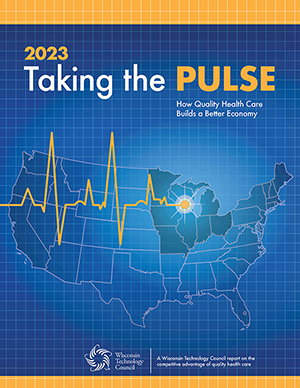Vol. 67, Issue 10
View more issues of The Valued Voice
Sign Up for WHA's Newsletter
Click here to view past issues
IN THIS ISSUE
- GUEST COLUMN: Quality Health Care is Wisconsin Asset, But it Can’t be Taken for Granted
- New Assembly Health Committee Chair Speaks to WHA’s Public Policy Council
- Apply Now for WHA-Crafted Training Grants
- Register Today for the Second Annual Workforce Virtual Forum
- Hospital Board of Directors Education Day: Registration Still Open for Virtual Attendance
- REMINDER: Register for Advocacy Day, Legislative Visits
- RSVP for the Wisconsin Hospitals State PAC & Conduit Kick-off Breakfast
- WHA Health Care Leadership Academy Cohort Participates in Session on Executive Project Sponsorship
EDUCATION EVENTS
Jan. 14, 2026
Caring for Wisconsin’s Caregivers Well-Being First Champion Challenge for Credentialing KickoffJan. 28, 2026
2026 WHA Health Care Leadership AcademyFeb. 10, 2026
Age-Friendly Webinar Series Featuring Advocate HealthClick here to view education event calendar
View more issues of The Valued Voice
Sign Up for WHA's Newsletter
Thursday, March 9, 2023
 Most people rank the quality of the health care they receive in a hyper-personal way. If a doctor, nurse or clinician fix what ails them, people tend to give good marks. If health problems persist without a good explanation as to why, the bill for payment can look a lot bigger and a more critical view emerges. Right or wrong, that’s human nature.
Most people rank the quality of the health care they receive in a hyper-personal way. If a doctor, nurse or clinician fix what ails them, people tend to give good marks. If health problems persist without a good explanation as to why, the bill for payment can look a lot bigger and a more critical view emerges. Right or wrong, that’s human nature.
Health care quality and value can also be assessed in data-driven ways that look across larger populations, examine relative differences between states and consider other measurable factors.
The latter is what the Wisconsin Technology Council recently did in a report, “Taking the Pulse: How Quality Health Care Builds a Better Economy.” The conclusions are worth noting in an age when competing for workforce talent is a 50-state game. Here are examples:
 Those findings may not comfort people who had a bad experience in a Wisconsin clinic or hospital, or who think the entire health care system should be turned on its head. However, it’s one argument for Wisconsin’s competitiveness as a place to live and work.
Those findings may not comfort people who had a bad experience in a Wisconsin clinic or hospital, or who think the entire health care system should be turned on its head. However, it’s one argument for Wisconsin’s competitiveness as a place to live and work.
Top-quartile rankings for health-care quality and cost figures roughly in line with regional and national figures give Wisconsin workers and companies an edge for now—but workforce shortages that began even before COVID-19 and the need to stay abreast of technology make continued progress a challenge.
For example, Wisconsin hasn’t seen a rural hospital close since 2011 but pressures are mounting. Much like good broadband and housing, quality and available health delivery systems are essential to sustaining the rural economy. While Wisconsin ranks low on one “immediate risk of closure” list for rural hospitals, those hospitals face daily challenges.
The latest example came when the Marshfield Clinic Health System announced it will lay off 346 workers in Wisconsin. Its hospitals and clinics serve an almost entirely rural population. Rising labor costs, more expensive supplies and lower reimbursements were cited as reasons, but regulatory and other pressures facing health care nationally in the wake of the pandemic are also at work. State policymakers may be able to help in some ways:
Still can be reached at tstill@wisconsintechnologycouncil.com.
GUEST COLUMN: Quality Health Care is Wisconsin Asset, But it Can’t be Taken for Granted
By Tom Still, President, Wisconsin Technology Council
 Most people rank the quality of the health care they receive in a hyper-personal way. If a doctor, nurse or clinician fix what ails them, people tend to give good marks. If health problems persist without a good explanation as to why, the bill for payment can look a lot bigger and a more critical view emerges. Right or wrong, that’s human nature.
Most people rank the quality of the health care they receive in a hyper-personal way. If a doctor, nurse or clinician fix what ails them, people tend to give good marks. If health problems persist without a good explanation as to why, the bill for payment can look a lot bigger and a more critical view emerges. Right or wrong, that’s human nature.Health care quality and value can also be assessed in data-driven ways that look across larger populations, examine relative differences between states and consider other measurable factors.
The latter is what the Wisconsin Technology Council recently did in a report, “Taking the Pulse: How Quality Health Care Builds a Better Economy.” The conclusions are worth noting in an age when competing for workforce talent is a 50-state game. Here are examples:
- Wisconsin is consistently among the top states for quality health care, as measured by metrics compiled by the federal Agency for Healthcare Research and Quality (AHRQ). In its 2022 “National Healthcare Quality and Disparities Report,” the AHRQ ranked Wisconsin and 11 other states in the nation’s top quartile through 2021. In the region surrounding or within a day’s drive of Wisconsin, only three other states (Iowa, Minnesota and North Dakota) ranked in the top quartile.
- With some key indicators—such as mortality tied to health care, Medicare 30-day readmissions, penalized hospitals and average hospital length of stay—Wisconsin performance was well above average.
- Mean inpatient charges in Wisconsin were in the middle of the seven-state region in the latest year on record and leveling off, according to AHRQ. In contrast, the U.S. average was much higher and trending up.
- That cost-related finding was reinforced in a 2022 report by Forbes Advisor, which analyzed data from the Kaiser Family Foundation comparing all 50 states and the District of Columbia on average health care costs per person. The U.S. average was more than $10,000; Wisconsin was the 8th least expensive state with a per capita rate of $9,626. That same Forbes study found that Wisconsin’s health care cost increases over the past five years were sixth lowest in the nation.
- Most single and family health insurance premiums in Wisconsin were competitive with regional and U.S. averages in 2021. The exception was average premiums for family coverage paid by employers. That figure was $15,676, or second highest in the region and higher than the U.S. average of $15,207.
 Those findings may not comfort people who had a bad experience in a Wisconsin clinic or hospital, or who think the entire health care system should be turned on its head. However, it’s one argument for Wisconsin’s competitiveness as a place to live and work.
Those findings may not comfort people who had a bad experience in a Wisconsin clinic or hospital, or who think the entire health care system should be turned on its head. However, it’s one argument for Wisconsin’s competitiveness as a place to live and work.Top-quartile rankings for health-care quality and cost figures roughly in line with regional and national figures give Wisconsin workers and companies an edge for now—but workforce shortages that began even before COVID-19 and the need to stay abreast of technology make continued progress a challenge.
For example, Wisconsin hasn’t seen a rural hospital close since 2011 but pressures are mounting. Much like good broadband and housing, quality and available health delivery systems are essential to sustaining the rural economy. While Wisconsin ranks low on one “immediate risk of closure” list for rural hospitals, those hospitals face daily challenges.
The latest example came when the Marshfield Clinic Health System announced it will lay off 346 workers in Wisconsin. Its hospitals and clinics serve an almost entirely rural population. Rising labor costs, more expensive supplies and lower reimbursements were cited as reasons, but regulatory and other pressures facing health care nationally in the wake of the pandemic are also at work. State policymakers may be able to help in some ways:
- They can encourage teaching institutions to efficiently produce health care workers. An example is a Mayo Clinic partnership with UW-Eau Claire.
- While Wisconsin care rankings are better than most states, mental health treatment can still be hard to access—especially when opioids, fentanyl and other abused substances are killing far too many people. Some previously public mental health programs have been taken on by hospitals and health systems, but not without cost.
- Encourage more partnerships between Wisconsin health systems and tech-based providers. Wisconsin has world-class resources in health information, diagnostics, imaging and therapeutics. However, some hospitals can still be slow to innovate.
Still can be reached at tstill@wisconsintechnologycouncil.com.
Vol. 67, Issue 10
Thursday, March 9, 2023
GUEST COLUMN: Quality Health Care is Wisconsin Asset, But it Can’t be Taken for Granted
By Tom Still, President, Wisconsin Technology Council
 Most people rank the quality of the health care they receive in a hyper-personal way. If a doctor, nurse or clinician fix what ails them, people tend to give good marks. If health problems persist without a good explanation as to why, the bill for payment can look a lot bigger and a more critical view emerges. Right or wrong, that’s human nature.
Most people rank the quality of the health care they receive in a hyper-personal way. If a doctor, nurse or clinician fix what ails them, people tend to give good marks. If health problems persist without a good explanation as to why, the bill for payment can look a lot bigger and a more critical view emerges. Right or wrong, that’s human nature.Health care quality and value can also be assessed in data-driven ways that look across larger populations, examine relative differences between states and consider other measurable factors.
The latter is what the Wisconsin Technology Council recently did in a report, “Taking the Pulse: How Quality Health Care Builds a Better Economy.” The conclusions are worth noting in an age when competing for workforce talent is a 50-state game. Here are examples:
- Wisconsin is consistently among the top states for quality health care, as measured by metrics compiled by the federal Agency for Healthcare Research and Quality (AHRQ). In its 2022 “National Healthcare Quality and Disparities Report,” the AHRQ ranked Wisconsin and 11 other states in the nation’s top quartile through 2021. In the region surrounding or within a day’s drive of Wisconsin, only three other states (Iowa, Minnesota and North Dakota) ranked in the top quartile.
- With some key indicators—such as mortality tied to health care, Medicare 30-day readmissions, penalized hospitals and average hospital length of stay—Wisconsin performance was well above average.
- Mean inpatient charges in Wisconsin were in the middle of the seven-state region in the latest year on record and leveling off, according to AHRQ. In contrast, the U.S. average was much higher and trending up.
- That cost-related finding was reinforced in a 2022 report by Forbes Advisor, which analyzed data from the Kaiser Family Foundation comparing all 50 states and the District of Columbia on average health care costs per person. The U.S. average was more than $10,000; Wisconsin was the 8th least expensive state with a per capita rate of $9,626. That same Forbes study found that Wisconsin’s health care cost increases over the past five years were sixth lowest in the nation.
- Most single and family health insurance premiums in Wisconsin were competitive with regional and U.S. averages in 2021. The exception was average premiums for family coverage paid by employers. That figure was $15,676, or second highest in the region and higher than the U.S. average of $15,207.
 Those findings may not comfort people who had a bad experience in a Wisconsin clinic or hospital, or who think the entire health care system should be turned on its head. However, it’s one argument for Wisconsin’s competitiveness as a place to live and work.
Those findings may not comfort people who had a bad experience in a Wisconsin clinic or hospital, or who think the entire health care system should be turned on its head. However, it’s one argument for Wisconsin’s competitiveness as a place to live and work.Top-quartile rankings for health-care quality and cost figures roughly in line with regional and national figures give Wisconsin workers and companies an edge for now—but workforce shortages that began even before COVID-19 and the need to stay abreast of technology make continued progress a challenge.
For example, Wisconsin hasn’t seen a rural hospital close since 2011 but pressures are mounting. Much like good broadband and housing, quality and available health delivery systems are essential to sustaining the rural economy. While Wisconsin ranks low on one “immediate risk of closure” list for rural hospitals, those hospitals face daily challenges.
The latest example came when the Marshfield Clinic Health System announced it will lay off 346 workers in Wisconsin. Its hospitals and clinics serve an almost entirely rural population. Rising labor costs, more expensive supplies and lower reimbursements were cited as reasons, but regulatory and other pressures facing health care nationally in the wake of the pandemic are also at work. State policymakers may be able to help in some ways:
- They can encourage teaching institutions to efficiently produce health care workers. An example is a Mayo Clinic partnership with UW-Eau Claire.
- While Wisconsin care rankings are better than most states, mental health treatment can still be hard to access—especially when opioids, fentanyl and other abused substances are killing far too many people. Some previously public mental health programs have been taken on by hospitals and health systems, but not without cost.
- Encourage more partnerships between Wisconsin health systems and tech-based providers. Wisconsin has world-class resources in health information, diagnostics, imaging and therapeutics. However, some hospitals can still be slow to innovate.
Still can be reached at tstill@wisconsintechnologycouncil.com.
IN THIS ISSUE
- GUEST COLUMN: Quality Health Care is Wisconsin Asset, But it Can’t be Taken for Granted
- New Assembly Health Committee Chair Speaks to WHA’s Public Policy Council
- Apply Now for WHA-Crafted Training Grants
- Register Today for the Second Annual Workforce Virtual Forum
- Hospital Board of Directors Education Day: Registration Still Open for Virtual Attendance
- REMINDER: Register for Advocacy Day, Legislative Visits
- RSVP for the Wisconsin Hospitals State PAC & Conduit Kick-off Breakfast
- WHA Health Care Leadership Academy Cohort Participates in Session on Executive Project Sponsorship

